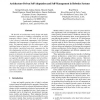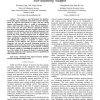403 search results - page 35 / 81 » Using Adaptation Plans to Control the Behavior of Models@run... |
SASO
2009
IEEE
15 years 4 months ago
2009
IEEE
This paper introduces MOCAS (Model Of Components for Adaptive Systems), a generic state-based component model which enables the self-adaptation of software components together wit...
ICSE
2009
IEEE-ACM
14 years 7 months ago
2009
IEEE-ACM
We describe an architecture-centric design and implementation approach for building self-adapting and selfmanaging robotics systems. The basis of our approach is the concept of me...
AIED
2005
Springer
15 years 3 months ago
2005
Springer
SuperDuperWalker is a software-based framework for experiments on the evolution of locomotion. It simulates the behavior of evolving agents in a 3D physical simulation environment ...
IROS
2008
IEEE
15 years 4 months ago
2008
IEEE
This paper presents a new method called Transition-based RRT (T-RRT) for path planning problems in continuous cost spaces. It combines the exploration strength of the RRT algorith...
IROS
2006
IEEE
15 years 3 months ago
2006
IEEE
- We propose a novel framework for imitation learning that helps a humanoid robot achieve its goal of learning. There are apparent discrepancies in shapes and sizes among humans an...


